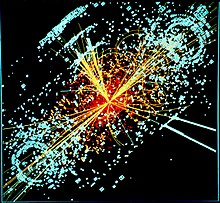
Neutrino oscillation

Neutrino oscillation is a quantum mechanical phenomenon whereby a neutrino created with a specific lepton family number ('lepton flavor': electron, muon, or tau) can later be measured to have a different lepton family number. The probability of measuring a particular flavor for a neutrino varies between 3 known states, as it propagates through space. Neutrino oscillation is a quantum mechanical phenomenon whereby a neutrino created with a specific lepton family number ('lepton flavor': electron, muon, or tau) can later be measured to have a different lepton family number. The probability of measuring a particular flavor for a neutrino varies between 3 known states, as it propagates through space. First predicted by Bruno Pontecorvo in 1957, neutrino oscillation has since been observed by a multitude of experiments in several different contexts. Notably, the existence of neutrino oscillation resolved the long-standing solar neutrino problem. Neutrino oscillation is of great theoretical and experimental interest, as the precise properties of the process can shed light on several properties of the neutrino. In particular, it implies that the neutrino has a non-zero mass, which requires a modification to the Standard Model of particle physics. The experimental discovery of neutrino oscillation, and thus neutrino mass, by the Super-Kamiokande Observatory and the Sudbury Neutrino Observatories was recognized with the 2015 Nobel Prize for Physics. A great deal of evidence for neutrino oscillation has been collected from many sources, over a wide range of neutrino energies and with many different detector technologies. The 2015 Nobel Prize in Physics was shared by Takaaki Kajita and Arthur B. McDonald for their early pioneering observations of these oscillations. Neutrino oscillation is a function of the ratio L⁄E, where L is the distance traveled and E is the neutrino's energy. (Details in § Propagation and interference below.) Neutrino sources and detectors are far too large to move, but all available sources produce a range of energies, and oscillation can be measured with a fixed distance and neutrinos of varying energy. The preferred distance depends on the most common energy, but the exact distance is not critical as long as it is known. The limiting factor in measurements is the accuracy with which the energy of each observed neutrino can be measured. Because current detectors have energy uncertainties of a few percent, it is satisfactory to know the distance to within 1%. The first experiment that detected the effects of neutrino oscillation was Ray Davis's Homestake experiment in the late 1960s, in which he observed a deficit in the flux of solar neutrinos with respect to the prediction of the Standard Solar Model, using a chlorine-based detector. This gave rise to the Solar neutrino problem. Many subsequent radiochemical and water Cherenkov detectors confirmed the deficit, but neutrino oscillation was not conclusively identified as the source of the deficit until the Sudbury Neutrino Observatory provided clear evidence of neutrino flavor change in 2001. Solar neutrinos have energies below 20 MeV. At energies above 5 MeV, solar neutrino oscillation actually takes place in the Sun through a resonance known as the MSW effect, a different process from the vacuum oscillation described later in this article. Following the theories that were proposed in the 1970s suggesting unification of weak, strong and Electromagnetic forces, a few experiments on proton decay followed in the 1980s. Large detectors such as IMB, MACRO, and Kamiokande II have observed a deficit in the ratio of the flux of muon to electron flavor atmospheric neutrinos (see muon decay). The Super-Kamiokande experiment provided a very precise measurement of neutrino oscillation in an energy range of hundreds of MeV to a few TeV, and with a baseline of the diameter of the Earth; the first experimental evidence for atmospheric neutrino oscillations was announced in 1998. Many experiments have searched for oscillation of electron anti-neutrinos produced at nuclear reactors. No oscillations were found until the detector was installed at a distance 1–2 km. Such oscillations give the value of the parameter θ13. Neutrinos produced in nuclear reactors have energies similar to solar neutrinos, of around a few MeV. The baselines of these experiments have ranged from tens of meters to over 100 km (parameter θ12). Mikaelyan and Sinev proposed to use two identical detectors to cancel systematic uncertainties in reactor experiment to measure the parameter θ13.
